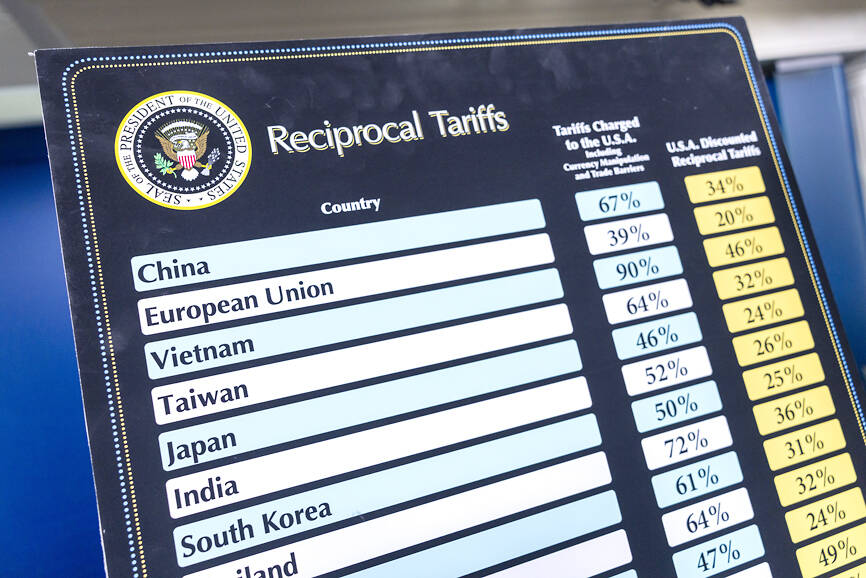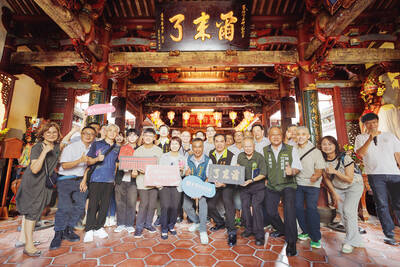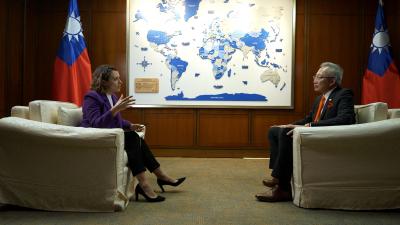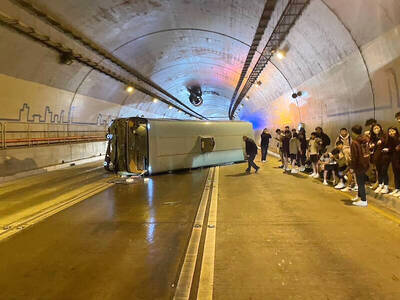The 20 percent tariff that the administration of US President Donald Trump has imposed on Taiwan appears “reasonable” compared with the rates imposed on other economies in the region, and a rate cut is possible after further negotiations, US experts said on Friday.
The levy, which was lower than the 32 percent announced by the US on April 2, matches those applied to Vietnam, Sri Lanka and Bangladesh, but is higher than the 15 percent for Japan, South Korea and the EU, and the Philippines’ 19 percent.
The announcement came one day before Friday’s deadline for countries to reach agreements with the US on tariff reductions.

Photo: EPA-EFE
Hudson Institute senior fellow Riley Walters said that 20 percent is a “pretty reasonable” rate for Taiwan, as the country did not have to “offer up hundreds of billions of dollars worth of new investment or agricultural purchases, Boeing purchases or the removal of non-tariff barriers.”
Walters said that Japan’s 15 percent rate was a privilege the country “paid for,” as Tokyo had to pledge to invest US$550 billion in the US market, adding that Taiwan’s rate was only slightly higher than that of many of its regional competitors.
President William Lai (賴清德) called the rate “provisional,” saying that the US remains open to further tariff discussions with Taiwan, as the trade deal was yet to be finalized.
US-based economics analyst Jeffrey Kuo (郭哲瑋) said that Trump’s tariff policies were a politically oriented announcement, adding that he does not see any theory behind the tariffs.
“I think it is possible for Taiwan to see a cut from 20 percent if Taipei is able to offer more incentives to Washington and come up with more policies to benefit the US, such as the creation of more jobs through more investments in US markets,” he said. “Taiwan has to make a concession for a tariff cut.”
Walters said it would be challenging for Taiwan to secure a lower tariff, because “there is really no telling how low this [Trump] administration wants to go on tariffs.”
A lower tariff would depend on the trajectory of the trade deficit the US has with Taiwan, he said, adding that if the trade deficit shows signs of trending lower, Taipei could seek a lower tariff rate.
Taiwan is the sixth-largest contributor to the US trade deficit, with Taipei’s trade surplus with the US increasing from US$47.8 billion in 2023 to US$73.9 billion last year.
Taiwan could promise new investments as leverage, but “there is a level of this administration that just wants to see higher tariffs, and there is no negotiating around that,” Walters added.
With Trump advocating “Made in the US,” his administration has urged the manufacturing sector to return to US soil by imposing tariffs on certain industries, such as 25 percent on the auto industry and 50 percent on steel and aluminum goods.
The US is likely to impose a minimum rate of 15 percent on semiconductor imports, but there could be exclusions, as seen occasionally in Trump’s tariff arrangements over the past six months, he said, adding that companies should try to seek an exclusion on semiconductors if a levy is imposed.
“Maybe they’ll be lucky enough for their products to avoid such a high tariff rate,” Walters said.

The Central Weather Administration (CWA) today issued a "tsunami watch" alert after a magnitude 8.7 earthquake struck off the Kamchatka Peninsula in northeastern Russia earlier in the morning. The quake struck off the east coast of the Kamchatka Peninsula at 7:25am (Taiwan time) at a depth of about 19km, the CWA said, citing figures from the Pacific Tsunami Warning Center. The CWA's Seismological Center said preliminary assessments indicate that a tsunami could reach Taiwan's coastal areas by 1:18pm today. The CWA urged residents along the coast to stay alert and take necessary precautions as waves as high as 1m could hit the southeastern

The National Museum of Taiwan Literature is next month to hold an exhibition in Osaka, Japan, showcasing the rich and unique history of Taiwanese folklore and literature. The exhibition, which is to run from Aug. 10 to Aug. 20 at the city’s Central Public Hall, is part of the “We Taiwan” at Expo 2025 series, highlighting Taiwan’s cultural ties with the international community, National Museum of Taiwan Literature director Chen Ying-fang (陳瑩芳) said. Folklore and literature, among Taiwan’s richest cultural heritages, naturally deserve a central place in the global dialogue, Chen said. Taiwan’s folklore would be immediately apparent at the entrance of the

“China is preparing to invade Taiwan,” Deputy Minister of Foreign Affairs Francois Wu (吳志中) said in an exclusive interview with British media channel Sky News for a special report titled, “Is Taiwan ready for a Chinese invasion?” the Ministry of Foreign Affairs said today in a statement. The 25-minute-long special report by Helen Ann-Smith released yesterday saw Sky News travel to Penghu, Taoyuan and Taipei to discuss the possibility of a Chinese invasion and how Taiwan is preparing for an attack. The film observed emergency response drills, interviewed baseball fans at the Taipei Dome on their views of US President

Speeding and badly maintained roads were the main causes of a school bus accident on a rainy day in Taipei last year that severely injured two people and left 22 with minor injuries, the Taiwan Transportation and Safety Board said. On March 11 last year, a Kang Chiao International School bus overturned inside the Wenshan Tunnel (文山隧道) on the northbound lane of the Xinyi Expressway. The tour bus, owned by Long Lai Co, exceeded the speed limit after entering the tunnel, the board’s investigation found. Sensing that the rear of the vehicle was swaying, the driver attempted to use the service and exhaust